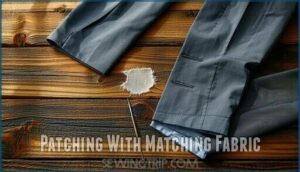This site is supported by our readers. We may earn a commission, at no cost to you, if you purchase through links.

For tiny holes, use darning stitches to weave new threads into the fabric. Medium holes need fabric patches cut from hidden areas like inner seams. Emergency repairs work well with double-sided fusible tape.
Match your thread color precisely – it’s the difference between an invisible repair and an obvious patch job. Professional tailors handle complex tears, but most home repairs save money and time. The secret lies in choosing the right technique for your specific fabric type.
Table Of Contents
Key Takeaways
- You’ll choose the right repair method based on hole size – darning works for small holes under half an inch, while larger tears need fabric patches or professional reweaving.
- You can achieve invisible repairs by matching thread color precisely and using proper techniques like darning stitches for tiny holes or fusible bonding for quick emergency fixes.
- You’ll save money by handling simple repairs yourself, but don’t hesitate to visit a professional tailor for holes larger than one inch, expensive suits, or complex damage that exceeds your skill level.
- You’ll prevent future holes by rotating suits regularly, storing them properly on hangers, checking pockets for sharp objects, and investing in professional cleaning to maintain fabric integrity.
Assessing The Damage to Suit Pants
Before you start any repair work, you’ll need to examine your suit pants carefully to determine the exact type and extent of damage.
Take a close look at the hole’s size, location, and the fabric around it to choose the most effective repair method.
Identify Hole Size and Location
Before you repair suit pants, start with a thorough hole assessment to map the damage. Check the hole’s diameter and depth to determine which repair method you’ll need.
Location matters too – tears near seams require different techniques than fabric damage in open areas. Document everything during your damage evaluation phase for effective repair planning.
Examine Fabric Type and Color
Once you’ve identified the hole’s size and location, fabric analysis becomes your next priority. Check the weave patterns and material science of your suit pants. Wool requires different thread selection than cotton or polyester blends.
Hold the fabric near natural light to examine color variations. Professional tailors know that even minor color mismatches become obvious under office lighting. Your repair success depends on accurate color matching and understanding the fabric’s unique characteristics for proper technique selection.
Evaluate Severity and Underlying Cause
Once you’ve analyzed your fabric type and color, determine how bad things really are. Look beyond surface damage to understand what caused the problem. Some holes spell disaster while others are quick fixes waiting to happen.
Damage Classification checklist:
- Size matters – Holes under half an inch are usually repairable at home
- Location impact – Knee and pocket areas face higher stress during wear
- Cause determination – Moths create clean holes, snags leave jagged edges
- Fabric analysis – Wool repairs differently than synthetic blends
- Repair feasibility – Multiple tears suggest fabric deterioration beyond simple patching
Understanding the underlying cause helps prevent future problems and guides your repair approach.
Tools and Materials Needed for Repair
You’ll need the right tools to achieve professional-quality repairs that won’t embarrass you in the boardroom.
Basic supplies include sharp fabric scissors, matching thread, appropriate needles, and pins to secure your work before stitching.
Essential Sewing Supplies
Every successful repair starts with your sewing notions foundation. Basic sewing kits include tailors scissors for clean cuts and fabric selection. Quality matching thread connects perfectly to your suit’s color palette. Various needle types serve different fabric weights.
From the simple slip baste stitch to more complex catch stitches, you’ll need essential supplies ready for any hole encounter. Having the right sewing kit essentials is vital for a professional-looking repair.
Choosing The Right Thread and Needles
When matching thread colors to your suit fabric, you’ll save yourself from obvious repair marks that scream "amateur hour." Thread selection requires precision – synthetic threads work best for wool suits, while cotton threads suit cotton fabrics. Here’s your thread and needle toolkit:
- Thread Colors: Match exactly using daylight or bring fabric samples to the store
- Needle Sizes: Use size 11-14 for lightweight wools, 16-18 for heavier fabrics
- Fabric Matching: Test thread tension on fabric scraps before starting repairs
Quality tailor scissors make clean cuts essential for professional results. Understanding the right suit threads is vital for a flawless repair.
Optional Tools for Advanced Repairs
Beyond basic needles and thread, professional-grade tools enhance your repair game. Sophisticated sewing machines handle delicate fabrics with precision control. Specialty threads like BoNash 007 match suit materials perfectly. Interfacing materials and textile reinforcements strengthen weak spots. Fabric adhesives and double-sided fusible create flawless bonds for invisible weaving techniques. For complex repairs, utilizing proper sewing machine tools is essential for achieving professional results.
| Tool Category | Purpose |
|---|---|
| Sophisticated Sewing Machines | Precision stitching control |
| Specialty Threads (BoNash 007) | Perfect color matching |
| Interfacing Materials | Fabric stabilization |
| Fabric Adhesives | Flawless bonding |
Step-by-Step Methods to Fix Holes in Suit Pants
You’ll master four proven repair techniques that restore your suit pants to their original condition. Each method requires specific tools and steps to achieve professional results at home.
Darning Small Holes by Hand
Hand darning works best for holes smaller than a dime. Thread your needle with matching thread, keeping it arm’s length to prevent tangling.
Create a darning stitch by weaving thread horizontally across the hole, then vertically through those threads. This fabric weaving technique basically rebuilds the cloth structure.
The needle techniques require patience—work slowly for invisible results in your suit pants.
Patching With Matching Fabric
When darning won’t cut it, patching becomes your go-to fix. Start with fabric selection that matches your suit’s material and weight. Focus on color matching and texture blending for invisible results.
Cut your patch slightly larger than the hole, ensuring pattern alignment if needed. Position the patch underneath, then mend using small stitches around the edges for seam reinforcement.
Using Fusible Bonding Agents
Fusible bonding agents offer a quick alternative when you can’t find matching fabric. These doublesided fusible webs create strong bonds using heat pressing techniques. Apply the fusible web behind the hole, then press with an iron following manufacturer instructions.
This fabric repair technique works best on small holes where bonding agents can bridge gaps effectively. Choose repair materials that match your suit’s weight and texture for ideal results.
For successful bonding, understanding fusible web tape properties is essential to achieve a strong and lasting bond.
Invisible Weaving for Professional Results
Invisible weaving represents the highest standard of suit pants hole repair. This professional darning technique recreates your fabric’s original weave pattern thread by thread. You’ll need matching thread harvested from hidden areas like hems. The process involves stabilizing damage, then methodically weaving individual warp and weft threads into the repair site.
- Thread matching requires sourcing material from concealed garment areas for perfect color alignment
- Weave restoration demands precise needle work to replicate original fabric patterns
- Fabric reinforcement stabilizes surrounding fibers before invisible stitching begins
Professional results usually cost $45-90 but guarantee repair longevity throughout garment life. For ideal results, understanding fabric reweaving techniques is essential.
Deciding Between DIY and Professional Tailoring
You’ll face a critical decision point after learning these repair methods: tackle the hole yourself or hand it over to a professional tailor.
The choice depends on factors like hole complexity, fabric value, your skill level, and budget constraints.
When to Visit a Local Tailor
Recognizing your limits saves time and money. You should visit a tailor when holes exceed one inch, appear in visible areas, or affect expensive suits. Complex fabric matching requires professional expertise.
Quality tailors provide time estimates and detailed repair costs upfront. Check local reviews before selecting a repair service. Professional results justify the investment for valuable garments.
Cost and Quality Considerations
Tailors charge between $15-$25 for basic repairs, while cashmere hole repair runs higher due to fabric costs. Material selection affects pricing substantially when matching luxury fabrics.
Professional quality control ensures invisible results, but repair estimates can surprise you. Budget planning matters—a $20 patch beats replacing $400 suit pants.
Get written quotes before committing to avoid sticker shock at pickup time. **Understanding alteration costs is vital for planning repairs.
Finding Reputable Reweaving Services
Professional referrals from established tailors often lead you to the best reweaving specialists. Look for providers who demonstrate fabric matching expertise through before-and-after photos of suit pants repairs. Check tailor reviews focusing on service quality and invisible repair results.
Reputable reweavers quote transparently for hole repairs, avoiding surprise reweaving costs while delivering professional-grade suit restoration.
When considering alterations, understanding the process of tailoring pants is essential for achieving a perfect fit.
Preventing Future Damage to Suit Trousers
You can’t fix what’s already broken, but you can stop future damage with smart prevention strategies.
Proper maintenance and targeted reinforcement protect your investment and keep your suit trousers looking professional for years to come.
Proper Care and Maintenance Tips
Proper suit care prevents holes before they happen. Store your custom pants on hangers to avoid creasing stress points. Regular fabric protection treatments create barriers against snags and wear.
- Dry clean suits every 3-4 wears to maintain fabric integrity
- Rotate between multiple pairs to reduce daily wear patterns
- Use cedar blocks during storage methods to repel moths
- Check pockets before cleaning to prevent laundry tips disasters
- Brush fabric gently after each wear to remove surface debris
These garment longevity practices save money and keep your investment looking sharp for years.
Reinforcing High-Wear Areas
Strategic fabric reinforcement transforms vulnerable spots into bulletproof zones. Focus on crotch areas, inner thighs, and pocket edges where friction creates weakness.
Apply iron-on patches or hand-stitch interfacing behind high-stress seams for tear resistance. Strengthen belt loops and reinforce hem edges with double-folded fabric.
These wear prevention techniques stop problems before they start, giving your suit pants the armor they need.
Sustainable Repair Practices
Every repair you make keeps another suit out of landfills. Choose eco-friendly materials like organic cotton patches when fixing your suit pants. A skilled tailor using green tailoring methods transforms damaged clothing into lasting pieces through sustainable fashion practices. By using techniques that involve proper fabric storage, you can extend the life of your garments and reduce waste.
- Rescue forgotten garments from your closet’s back corners
- Transform clothing waste into creative patch materials
- Support textile recycling programs in your community
- Choose repair over replacement to break the throwaway cycle
- Share mending skills with friends and family
Frequently Asked Questions (FAQs)
How long does reweaving take and is it worth the cost?
Joe’s $3,000 Armani suit had a moth hole at the knee. Reweaving usually takes 2-4 weeks and costs $185-$395 per hole .
Worth it? Absolutely – replacing that suit would cost thousands more.
Are there any alternative methods to patching suit pants?
You can try darning with matching thread, invisible weaving through a professional service, or using fusible bonding agents for small holes. Each method offers different results.
How can I prevent holes from forming in my suit pants in the future?
Like knights protecting their armor, you’ll prevent holes by rotating suits regularly, using quality hangers, avoiding rough surfaces, checking pockets for sharp objects, and investing in professional cleaning to maintain fabric integrity.
Can holes in expensive suit fabrics be repaired?
Expensive suit fabrics can be professionally repaired using invisible weaving or darning techniques. Skilled tailors match threads precisely, restoring fabric integrity.
Quality materials actually respond better to expert repairs than cheaper alternatives.
Will repairs show under bright office lighting conditions?
Professional repairs using matching thread and invisible weaving techniques remain virtually undetectable under bright office lighting. Quality workmanship ensures flawless blending with surrounding fabric.
What causes mysterious holes to appear in pants?
Like sneaky clothing criminals, mysterious holes appear from several culprits: clothes moths feeding on fabric fibers, belt buckles rubbing against thin material, and even hidden washing machine damage.
Should both pant legs match after single repair?
No, both pant legs don’t need to match after repairing a single hole. Focus on making the repair invisible and durable rather than creating symmetrical alterations across both legs.
Conclusion
Why let a small hole ruin your favorite suit when you can fix it yourself? Learning how to fix a hole in suit pants saves money and extends your garment’s life.
You’ve got multiple repair options depending on damage severity. **Small holes respond well to darning techniques.
** Larger tears need fabric patches or professional reweaving. Emergency situations call for fusible bonding agents.
With proper tools and patience, you’ll achieve professional-looking results. Remember that prevention beats repair through proper care and maintenance habits.
- https://embassycleaners.com/a-care-guide-repair-tips-for-tailored-pants/
- https://bowties.com/blogs/the-gentlemans-guide/the-art-of-suit-repair-on-the-go
- https://sewguide.com/clothing-repair-mending-tears/
- https://www.youtube.com/watch?v=TnxGHRlevlQ
- https://www.reddit.com/r/Tailors/comments/114mov4/how_to_repair_hole_or_moth_hole_in_dress_pants_so/
















